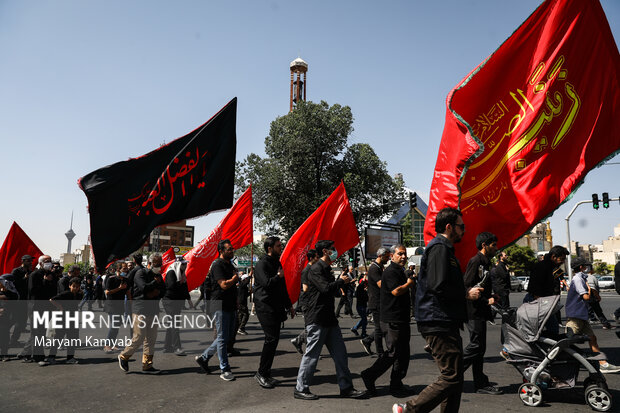Tasu’a is the ninth day of Muharram, one of the important days for Shia Muslims which is related to the event of Karbala, dating back to the year 61 Hejira.
The Day of Tasu'a is the last day Imam Hussein (AS) and his companions spent the night on and that day is remembered with the “Eve of Ashura”.
Tasu’a is associated with Imam Hussein’s half-brother, Abolfazl al-Abbas, who fought alongside the Imam against the army of Yazid. Abolfazl is highly revered among Muslims as a symbol of loyalty.
On the ninth day of Muharram, Shemr entered Karbala with a letter written by Ubayd Allah ibn Ziyad, in which, Umar ibn Sa’ad was requested either to show seriousness in contact with Imam Hussein (PBUH) or delegate the commandership of the army to Shemr.
Umar Sa’ad prevented delegating commandership of the army to Shemr and prepared to wage war against Imam Hussein (PBUH).
With the rush of armies on the day of Tasu’a, Imam Hussein (PBUH) sent Abolfazl al-Abbas (PBUH) and urged them to give a moratorium to pray and recite the Holy Quran.
According to historical resources, Shemr on the forenoon of the Tasu’a along with 4,000-member military men entered Karbala land and territory, carrying a letter from Ubayd Allah ibn Ziyad addressed to Umar ibn Sa’ad. In this matter, ibn Ziyad had requested ibn Sa’ad either force Imam Hussein (PBUH) to accept allegiance or prepare himself for battle.
Umar ibn Sa’ad, after reading the letter, appointed Shemr as commander of the infantry of his army.
On this day, Shemr sent a guarantee of safe conduct to Abolfazl al-Abbas (PBUH) and other offspring of Umm ul-Banin but Hazrat Abbas (PBUH) did not accept. Shia Muslims consider and attribute Tasu’a to Hazrat Abbas (PBUH) and endear it like the Day of Ashura and mourn for the perfections of the Imam.
Historically speaking, the army of Yazid laid siege to Imam Hussein (AS) and his followers in the desert near Kerbala on the first day of Muharram. The Imam and his loyal supporters were massacred in battle 10 days later after he had refused to pledge allegiance to Yazid.

On the day of Tasu'a, Muslims across the globe take to the streets to hold mourning rituals in commemoration of Imam Hussein (AS), the grandson of Prophet Muhammad.
People in Iran and some predominantly Shia Muslim countries mark Tasu’a with mourning by launching chest- and chain-beating religious boards.
Black-clad mourners take to the streets in Iran to mark Tasu'a, the day before the third Shia Imam and 72 of his loyal companions were martyred by the authoritarian rulers of the time nearly 1400 years ago.
The ultimate tragedy here is that Imam Hussein (AS) was the grandson of Prophet Muhammad. Of his grandson, he says the famous words, Hussein is from me, and I am from Hussein. Allah loves whosoever loves Hussein.

For Shia Muslims all over the world, Tasu'a is a special but extremely sad day.
War and fighting are prohibited during Muharram and festivities like weddings and birthdays are usually postponed to more appropriate days. People generally wear black out of respect or at least avoid wearing very bright colors.
The ritualistic bereavements of Muharram are a platform where various artistic genres like literature, painting, music, fiction, and drama are reconciled.
During Muharram, apart from mosques, each neighborhood sets up its establishment for the ceremonial processions of the month known as ‘Tekkiyeh’, which are venues for the gathering of mourners known as ‘Heyat’ (literally meaning group or delegation) who honor the life of Imam Hussein (AS).

The resilient beat of drums and a few other instruments are heard as people weep in the hymns and men in black rhythmically flagellate their backs with two pairs of chains and beat their chests with open palms. This ritual is known as Sineh-Zani (beating the chest).
Other communal forms of mourning include Tazieh, which is a passionate play usually performed during the first ten days of Muharram, culminating in a passionate and emotional peak on the tenth (Ashura). Stories and characters involved in the Karbala battle are enacted by men and young children. Needless to say, these rituals are region specific and quite diverse. Major theatre houses in Iran also stage plays relevant to this month.

Tazieh, which recounts religious events, historical and mythical stories, and folk tales, was registered on UNESCO’s List of the Intangible Cultural Heritage of Humanity in November 2010.
All government offices, universities, sporting arenas, cinemas as well as most tourist attractions like museums are closed during Tasu’a and Ashura.
During Muharram, particularly on Tasu’a and Ashura, people refrain from doing or saying things that may violate the honorable spirit of the month. Television and radio channels alter their timings and programs to accommodate more religious sermons, mourning songs, live ceremonies, and films about the spirit of the month.
Black as the color of mourning during this month is visible in people’s attire, banners hanging from buildings, billboards, decoration of city walls, and in the writings on the rearview windows of cars.
Reported by Amin Mohammadzadegan Khoyi





















Your Comment